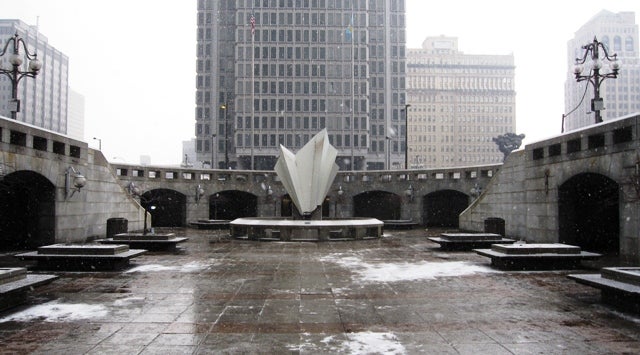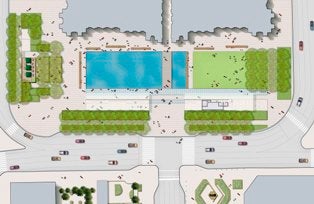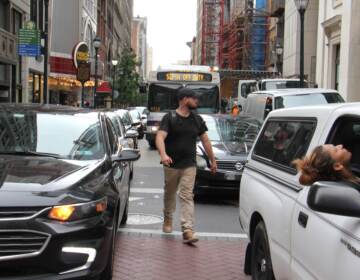Commentary: Get the Plaza right

Jan. 20
COMMENTARY / By Kiki Bolender and John Gibbons
The Center City District (CCD) is proposing a complete overhaul of the Dilworth Plaza, the public space to the west of City Hall. The concept has been taking shape over the last year, but there has been very little public interaction with and input into the design. We feel that this planning process, which directly impacts how Philadelphians view and use City Hall, merits serious consideration by the public and the design community.
A photo slide show and a three-part video tour of the site accompany this commentary. More detailed analyses of the proposed design are included by John Gibbons, co-chair of the AIA Urban Design Committee, and John Andrew Gallery, Executive Director of the Preservation Alliance of Greater Philadelphia.
A December 2008 video showing the presentation of the CCD plan to the Philadelphia City Planning Commission is also featured below.
The proposed budget for the renovation work is $40-45 million, with $20 million called for as part of Mayor Nutter’s request for federal economic stimulus funds.
The project was presented to the Art Commission this month and the Planning Commission in December. Approvals are expected this winter, with construction scheduled before the end of the year.
When then President-Elect Obama started his pre-inaugural train trip in Philadelphia on Saturday, he referred to us as a “resilient, generous and decent” people. Especially in these troubled times, we and our built works have to aspire to that standard.
_____________________________________________

According to CCD President and CEO Paul Levy, three structures are proposed – two along 15th Street – one as a stairway into traffic and the other housing a café and elevator access to the concourse. Both currently will have green roofs. A third smaller structure is contemplated along the north side aligned with a view up the Parkway. A smaller café and elevator access to concourse.
__________________________________________________
RESILIENT
An architect friend, reflecting on the CCD plan, said that we should “… always be hesitant to throw something away too soon.” Thirty years is not a long time for architecture of solid granite. The plaza was conceived as a connector between the concourse below and activity on the street level. Transit riders can enter or emerge from the lower level below as it suits their convenience. The proposed new design wipes all that out, replacing a complex series of level changes with a single stair located to reinforce a design idea that is not reflective of natural user patterns.
We need to take a nuanced look at the existing plaza, and see what could be wonderful, and what might be hopelessly ineffective. The south end, with its ponderous granite furnishings and scary space-age fountain, does not appear to have much to recommend it. But the north end has the potential to be a wonderful place, with a sunlit lower level full of moveable chairs and bright umbrellas in the summer, and a skating rink in the winter.
In place of solid granite the proposed design concept would give us a glass sidewalk running almost the entire width of City Hall. Is this a material to stand the rigors of winter and time? Once it is covered with salt in bad weather, will we be able to walk on it? Or will it just be cordoned off, like another forlorn office building plaza? When the sun comes out after the storm, will that glass be beautiful, or will it be scratched and clouded from the salt?
GENEROUS
In place of the present imaginative (albeit sometimes strange and foreboding) links between the street and the concourse, the CCD scenario “envisions the complete reconstruction of Dilworth Plaza on the west side of City Hall with a new high-visibility, transparent entrance to public transit …” (Center City: Planning for Growth, Broad Street and City Hall, page 4, April 2007). The two buildings proposed along 15th Street are 100 feet long and the height of a three story row house. The sides are glass, and the roof will be covered with earth for plantings. There is something amiss here. Air is holding up earth. Perhaps that is what happens when an object attempts to be both transparent and highly visible.
City Hall is a treasure – massive, quirky, over abundant in every way. (If you choose the right portal, you are greeted by carved elephants) As you approach it from the west on Market Street, each block reveals more and more of its outlandish width. The proposed pair of buildings would block that revelation, limiting your experience to the prescribed view. Stopped for the traffic light at Market Street, drivers would see transit entrances, not the seat of our government. Are these buildings generous? What do they give us? One replicates in function and type the SEPTA transit escalator enclosure across the street. According to Paul Levy, Executive Director of the CCD, the second is intended to house a café and provide elevator access to the concourse, both requiring solid enclosures within the glass.
Yet another building is proposed for the northwest corner of the site, with another point of elevator access, another café and a roof deck. The extraordinary view up the Parkway would be blocked, available only to those who could afford a seat on the roof. That is a total of three buildings in the plaza, each one blocking views to and from the plaza. Is the City eager to take on these high-maintenance structures? Is it realistic to imagine two cafes thriving in the plaza?
DECENT
Let’s just say for a moment that we get that $20 million from the federal government. Everything we build at this difficult and joyous moment in history should show our decency, our reaching out to one another, our standards of care. Does this design express those ambitions? A truly ambitious design would, with much greater modesty, find ways to make connections – connections to the concourse, to the buildings and plazas to the west and to the adjoining sides of City Hall. It would connect City Hall, that grand expression of our government, to its citizens and it would warmly welcome all visitors and passers by.
Opinions expressed in the article and the videos are those of the writers. AIA Philadelphia has not taken a position on the proposed project.
Kiki Bolender, AIA, LEED AP, Partner, Schade and Bolender Architects LLP, Philadelphia; Co-Chair Philadelphia Chapter AIA Urban Design Committee. Contact her at kiki@schadeandbolender.com

John Gibbons, AIA, AICP, Director of Architecture / Associate Principal, Kise Straw Kolodner, Philadelphia, Co-Chair Philadelphia Chapter AIA Urban Design Committee. Contact him at jgibbons@ksk1.com
WHYY is your source for fact-based, in-depth journalism and information. As a nonprofit organization, we rely on financial support from readers like you. Please give today.






